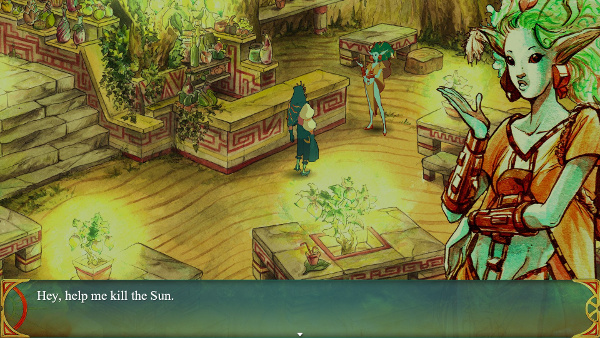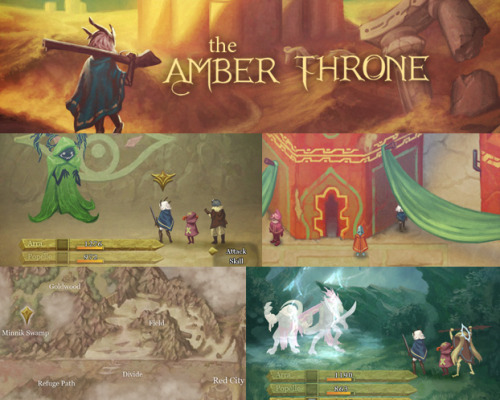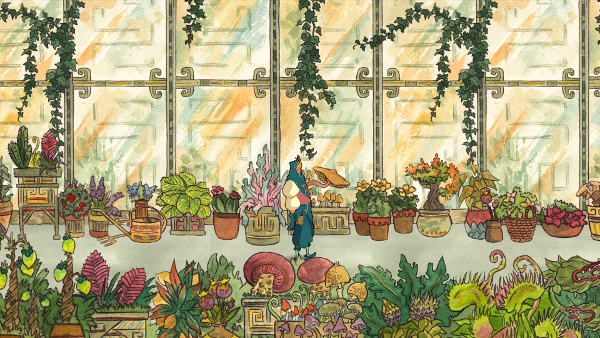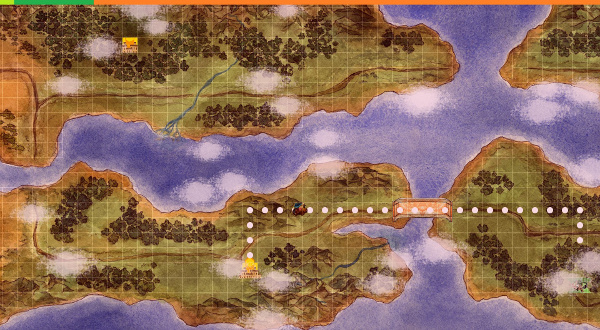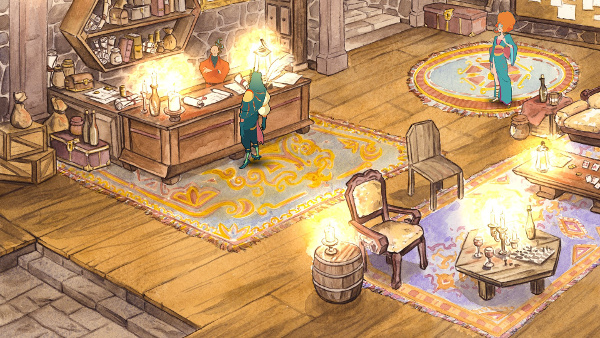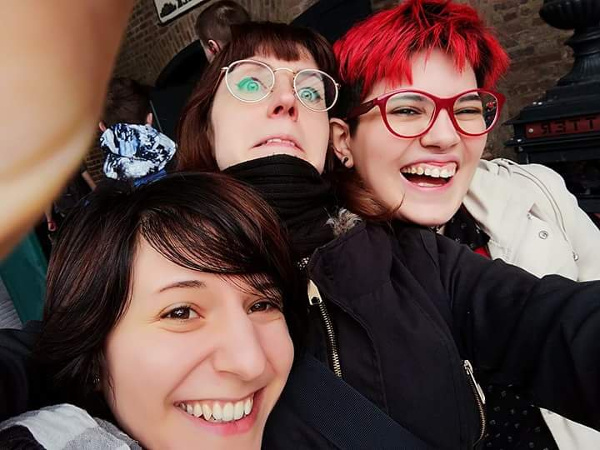A Chat With: Giada Zavarise
Hi Giada, can you tell us a little about yourself and what you do?
Hello! I am a comics person who somehow ended up writing for games instead. I am still very confused about my career.
I am mostly known for Selling Sunlight, a game about a wandering merchant who has no face because the Sun stole it. It’s a combatless RPG about bartering, meeting new cultures, befriending other merchants and traveling together, which I’m creating with the other members of CoseBelle. Our core team consists of me, Chiara Boscaro, and Anita Zaramella. The game was Kickstarted last October, and will hopefully get released in 2019. Meanwhile, you can try the demo here.
I also do freelance writing on the side. You can find my words on Rock, Paper, Shotgun, PC Gamer and Eurogamer, where I mostly try to convince people that RPG Maker games aren’t that bad.
It’s my understanding that you are developing Selling Sunlight in RPG Maker MV. At first glance this seemed a bit of an unorthodox choice for a large modern game given that RPG Maker first appeared over 25 years ago. Looking further, I was surprised to learn that MV itself was only released for PC 3 years ago, supports mobile games, and will soon have console releases. Would it be fair to say that the common perception of RPG Maker has significantly lagged behind the reality? Does this apply equally to developers and gamers?
I think there are numerous misconceptions about this engine, yeah. For more than a decade, people who played RPG Maker games were also RPG Maker developers. Occasionally weird games like Yume Nikki reached a larger audience, but for the most part, the community was composed of teens who wanted to create and share old-school RPGs. After the birth of Steam Greenlight, RPG Maker developers started putting their games on the platform. People took notice, and started critiquing those games for being boring, old-school, and not innovative enough, without realizing that that’s the whole point. RPG Maker games are easy to recognize, so the public started equating RPG Maker with games that all look the same and then, by extension, games that are all bad. It’s a messy situation. I wrote an article about it on Eurogamer.
From a developer’s point of view, RPG Maker is still not a great engine: it provides you with a solid framework for all your classic RPG needs, but trying to modify the default systems can be extremely frustrating. It also doesn’t allow you to export games to console, so forget that sweet Switch port. The console version will be a separate engine, and will only allow you to make and share games on a console. This sounds strange, but it’s not unusual for the series: every major console, from the DS to the PS2, got its own RPG Maker. The developers seem to consider it a game used to make games, more than an engine.
I rarely see RPG Maker being discussed in professional settings, and I think it’s a pity. I am tired of seeing Unity being recommended as the go-to engine. Not all developers like Unity. You don’t have to like it to be a games developer. Different engines cater to different needs, and we should encourage new developers to find the one that best fits their needs. We shouldn’t discourage people from using certain tools because they’re not “professional”—especially because most devs don’t know much about RPG Maker’s capabilities anyway. RPG Maker is quite flexible once you get the hang of it, but since most developers are young and/or inexperienced, you won’t see many people push the engine to its limits. Take a look at The Amber Throne or the recently released Heartbeat if you want to see examples of what can be achieved.
I got my fair share of mockery for using this dreaded engine. Nowadays, I never tell people which engine I’m using. I show them screens, and let them guess. The first comment inevitably is “I didn’t know you could do this in RPG Maker!”. It may not be a great engine, but it might be the right one for you.
You mentioned the article you published discussing the use of RPG Maker in games released on Steam. What would you say was the most interesting or surprising thing you found while gathering all the data?
The drop in reviews numbers before and after Steam Direct. Before Steam Direct, even the smallest RPG Maker games got a handful of reviews. After Direct’s launch, most games didn’t even manage to reach the minimum amount of reviews needed to get a score (10). We all read articles about Steam’s current state, but observing it so directly was chilling.
What history do you personally have with the various incarnations of the RPG Maker engine?
I downloaded a pirated copy of RPG Maker 2003 when I was 12, somehow believing I could use it to hack pokemon games. When I discovered the sad truth, I decided to make my own over-ambitious JRPG instead. I never accomplished anything of note, of course, but I became a quite proficient user and started helping other people. For years I moderated some of the biggest Italian communities; then I sort of drifted away as role-playing games swallowed my soul.
Ten years later, I found myself working in a marketing agency after trying, and failing, to get into comics. I was bored, underpaid and absolutely miserable, so I decided to start making a game. The latest version of RPG Maker had just been released, so I decided to try it out.
So that was how Selling Sunlight came to be made in RPG Maker. Did you consider switching to a different engine later on? Were there any worries about how using RPG Maker, with all the preconceptions around that, would affect the marketability of the game?
In narrative RPG Selling Sunlight, you are a wandering merchant whose face got stolen by the Sun. To get your identity back, you'll have to wander in a world that doesn't move anymore. One side of the planet boils, costantly facing the sun; the other is a frozen desert. The only habitable zone is a thin line of never-ending sunset, an orangish place full of fire spirits, wailing sun-priests, withering plant people, spiders and bees. Discover new wonders and cultures, make friends, trade and conspire against the Sun Himself to get your identity back. Will you ask for His pardon, or try to defile Him?
- Official website
Selling Sunlight did not start as a commercial project… However, when the project started to gather attention, I had to make a choice: stick to the dreaded RPG Maker, or switch to another engine (Unity?) and add who knows of many years of development to an already ambitious project.
I did not study to become a game developer. To make this game, I had to learn an awful number of new skills, from marketing to team management. Choosing RPG Maker meant having one less thing to worry about. I am familiar with the way this engine thinks, and I feel confident in my abilities to use it. This means I can focus on the stuff I am truly good at, like writing and design, instead of fighting against a new engine.
Sure, using a more flexible engine would have allowed me to make a slightly better, more polished game, but that ideal game would probably have never come out. Compromises aren’t pretty, but they’re the reason games get shipped.
Has the engine required you to use any interesting tricks to realise your vision of the game when you’ve pushed up against the edges of what is possible?
I am pushing the engine’s capabilities in every possible way, but you won’t notice it. The game’s map system’s for example, looks deceptively simple: you draw a path on a map, then push ok, and a little cart follows the path you have drawn. It’s nothing jaw-dropping. If you are an RPG Maker developer, though, you will know the way it works is not on the range of “stuff RPG Maker usually does”.
The trick I am most proud of, though, is my dialogue system. I’ll explain very quickly how it works.
All the dialogues are stored in arrays. The game looks at the first element of the array, and then decides what to do with the other data. If the first element says “dialogue”, for example, the game puts all the following data in a text box. If the first element says “picture”, the game gets it doesn’t have to show the following word, but needs to find a picture with the same name and show it on screen.
I started with a few commands, but now have elaborate commands that allow me to show pictures, advance quests and change stats directly from the dialogue files. I can program entire cutscenes without even opening the engine! I hope to release it to the public one day.
Finally, credit where it’s due: I am not a great coder, and I would be helpless without the support of the RPG Maker’s community. Many tricks I use to make Selling Sunlight look this pretty are only possible to the plugins many creators released for free. Don’t feel ashamed about using plugins! You don’t have to reinvent the wheel every time.
The team that you are developing Selling Sunlight with is made up of former students of the International School of Comics in Padua, Italy and the team itself is based in Italy. During the lead up to the Selling Sunlight Kickstarter you took part in the Failbetter Games incubation program, requiring you to move to England for 8 months. How was your experience of the program?
Failbetter Games’ incubation program allowed me to take advantage of their office space, ask for their expertise and observe how a Real Videogames Studio functions. They helped me shape a confused dream into a real game but, most importantly, they made me understand games can be a career. Games development is still not seen as a “real job” in my country. Getting to know other professionals gave me a sense of legitimacy that still keeps me going.
With the rest of your team remaining in Italy, did you have any problems coordinating with them? Did you adopt any particular strategies?
Not really. Public transportation is quite inefficient here, so even though we live in the same region, meeting in person can be a gruesome process. We only meet to brainstorm new locations and characters, and organize the rest of the work through messenger.
We have known each other for years, and this helps. We all also juggle assorted part-time jobs while working on Selling Sunlight, so we just… work on it whenever we got the time. We are quite terrible at organizing, really. When we become rich, we shall hire a producer.
Finally, can you tell us about any interesting projects or activities we should look out for that you have coming up in the future?
I am excited to announce I wrote a story for Mythos Across America, the new campaign of Cthulhu Chronicles! When is it coming out? I have no idea! But you can download the app already, play through the first campaign, and follow MetaArcade on Twitter for further announcements!
I hope you found this chat interesting. You can find Giada on Twitter and if you’re interested in checking out Selling Sunlight then you can find more information on the official website.
Tags: CoseBelle, Giada Zavarise, RPG Maker, Selling Sunlight
